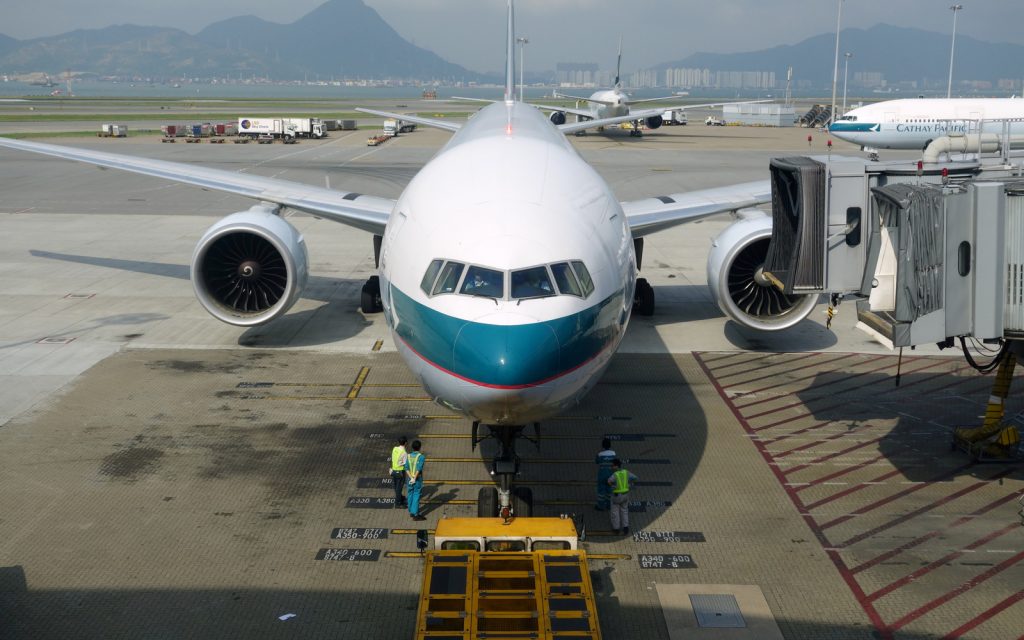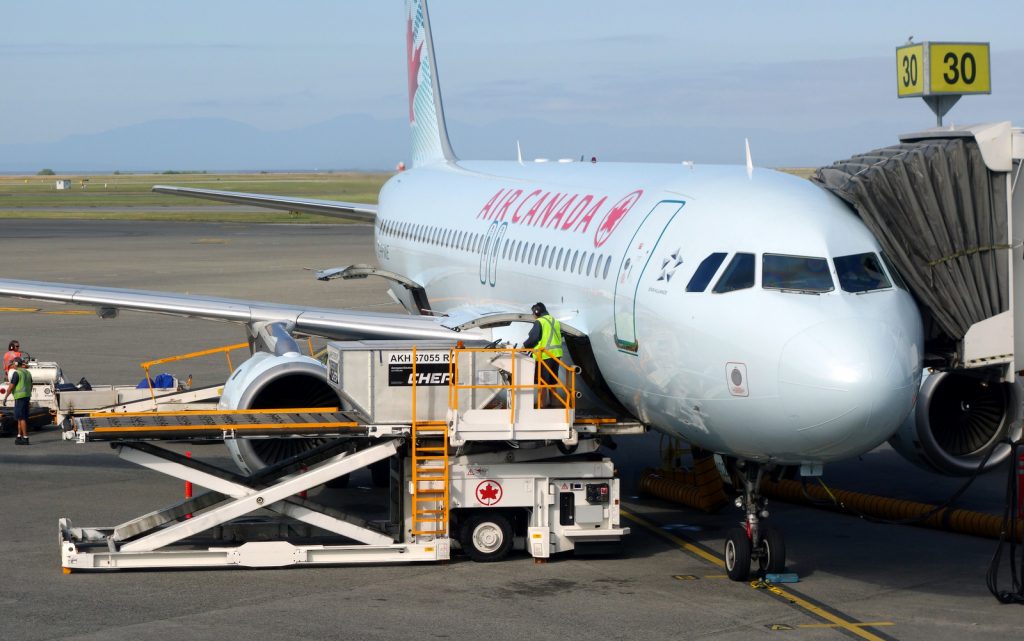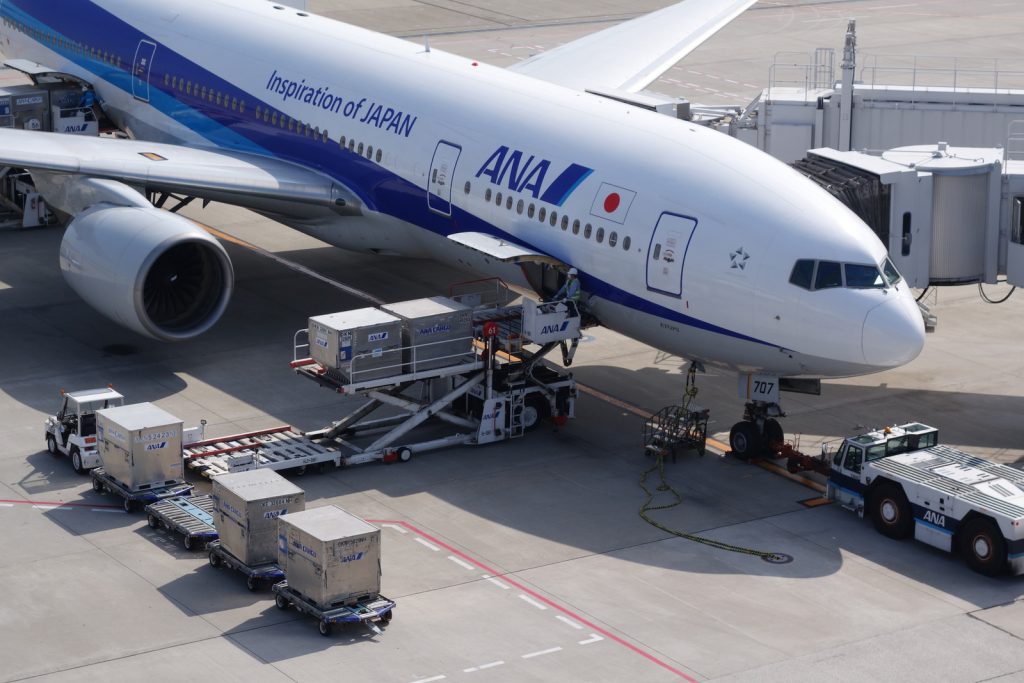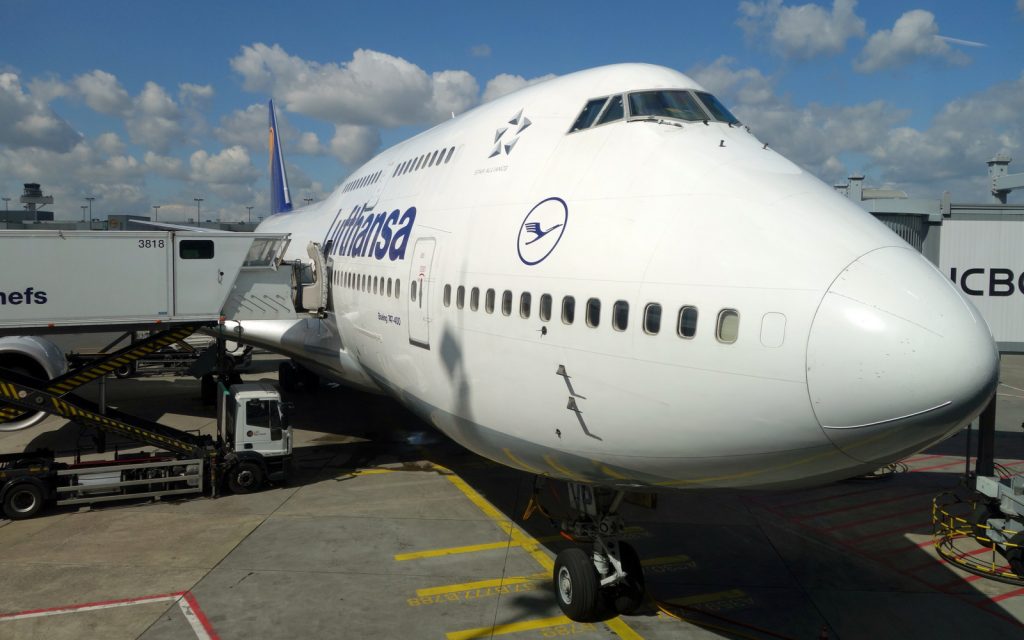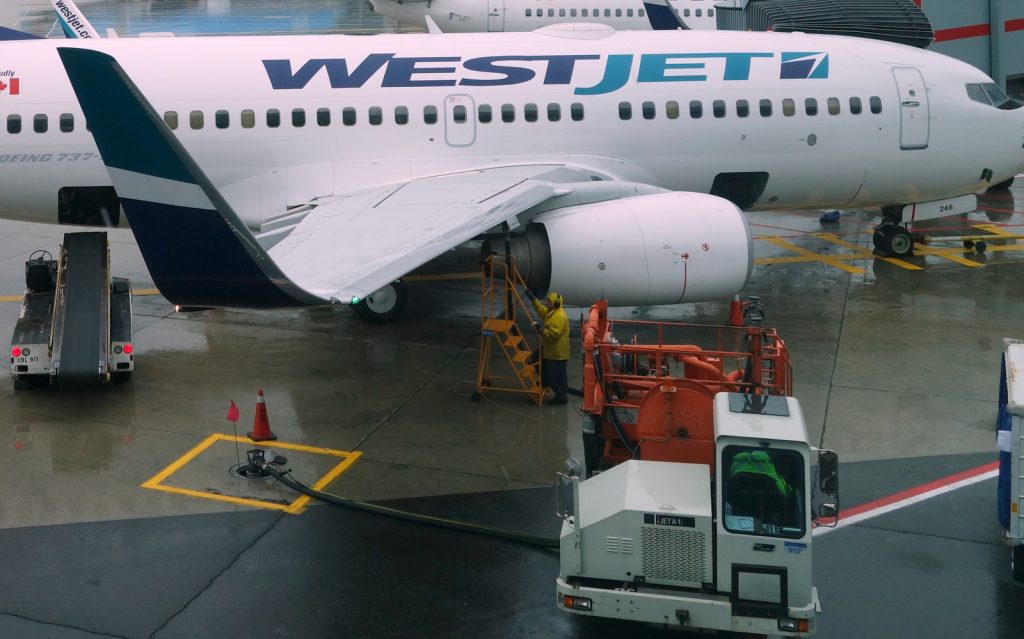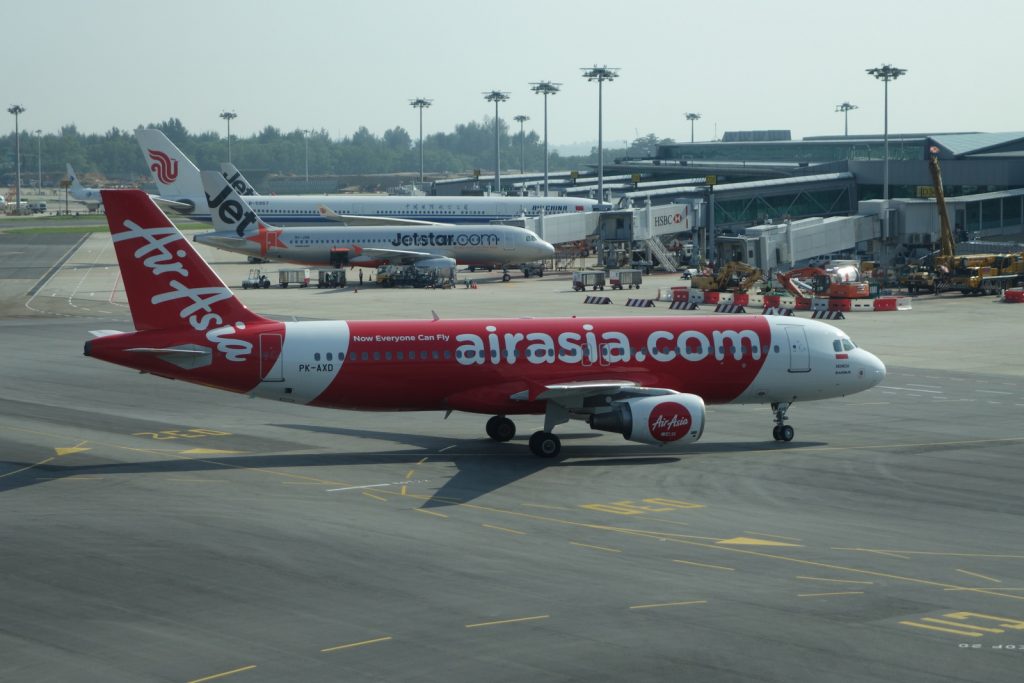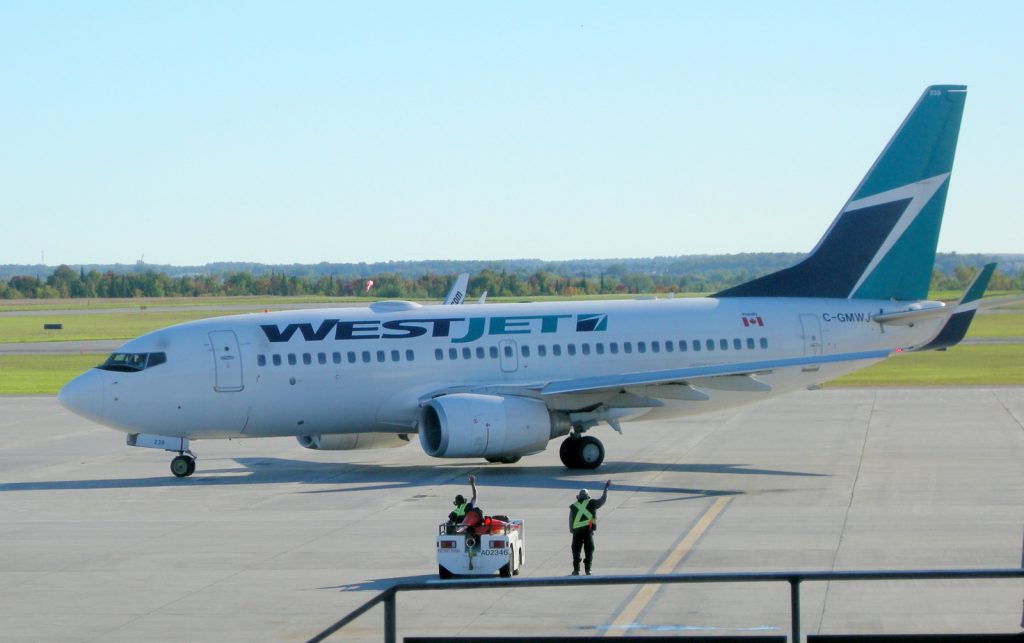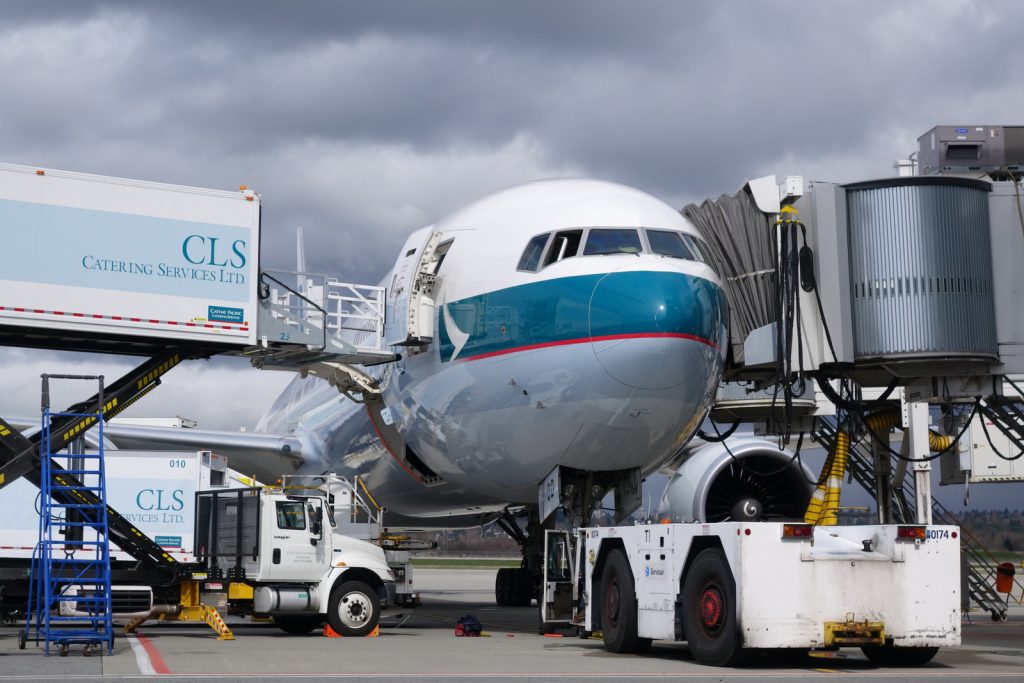
A Cathay Pacific Boeing 777-300 in the midst of a turnaround at YVR. You can see the yellow air conditioning hoses under the bridge.
Written for AirlineReporter.com
Your flight has landed, and the plane is pulling up to the gate. You’re ready to spring into action as soon as you hear the “we’re stopped” chime. But instead of jumping up and waiting in the aisle, why don’t you relax in your window seat, and look outside? You do have a window seat, don’t you? There’s quite the dance of people and equipment happening, all to service the plane and get it ready for its next flight.
The turnaround actually begins long before the plane lands. Equipment is pre-positioned at the gate, supplies and catering are prepared, and ramp and terminal staff get ready for the arrival. As the flight turns onto the taxiway after landing, the crew gets their gate assignment from ground control, or in the case of a major airport, ramp control. The plane’s Auxiliary Power Unit (APU) will have been started to provide an electrical and pneumatic supply after the engines are shut down. The APU is a small jet engine, generally located in the tail cone. One of the first airliners with an APU was the tri-jet Boeing 727, and its APU was located in the wing root.

Alaska ramp ops at SEA. That’s a fuel pump cart below the end of the wing, and you can see the crossbars on the gate’s lead-in line.
Your pilots have navigated their way from the runway to the ramp, and are approaching the gate. From your window seat, you may have seen gate numbers on the side of the terminal. The numbers might or might not match the gate number you find inside the terminal. For example, the gate might be D46 in the terminal, but Gate 125 on the pilots’ ramp diagram.
As the plane turns into the gate, the pilots are likely following a lead-in light system so that the plane will be in the correct position when it stops, to be sure that the aircraft bridge can mate with the plane’s door. The ramp crew is also watching the progress of the plane along the gate centerline. They’re making sure that nothing is in the way. You might see one of the ramp crew off a wingtip holding up an orange wand, showing that the way is clear.
You might be able to see the centerline markings at the gate next to you, or from inside the terminal. You’ll notice painted cross-bars near the end of the centerline closest to the bridge. Each bar corresponds to the spot that the nosewheel of a specific type of plane must stop, again for the positioning of the aircraft bridge. You can tell how long ago the cross-bars have been updated – check for a “DC-10” or “L1011” or other old types painted by the bars.
The pilots certainly can’t see the nosewheel below and behind them (unless they have one of those nifty belly cams), so they get their stopping cue from the light system or the ground crew. Just after the plane stops and the pilots set the brakes, the ramp crew puts chocks on the nose gear to stop the plane from rolling, and they STAY AWAY FROM THE ENGINE INTAKES! The amount of air that any modern turbofan sucks in is prodigious. Anything or anyone nearby is in danger of testing the engine’s ability to handle “foreign objects”.
When the plane is stopped, the pilots shut down the engines once the plane’s power is switched to the electrical supply from the APU. The APU gets fuel from the plane’s tanks, so some airlines are reducing the use of APUs to save gas, by connecting to power supplied at the gate. The power comes from a truck-mounted generator or directly from the terminal’s power system. Some airports, like Tokyo-Haneda, have ground power feeds built right into the surface of the apron.
As you might expect, the power requirements are pretty substantial. In the case of the highly-electric Boeing 787, the plane needs two 115 Volt AC connections, running at 90 Kilovolt Amperes (KVA) and 400 Hertz (HZ), just for normal ground ops. Smaller aircraft generally have one power connection. A plane’s ground power connections are usually located near the nose gear.
The ramp crew or mechanics next grab a giant safety pin attached to a large fabric “Remove Before Flight” banner. The pin is installed on the nose gear in a specific spot that disables the nose wheel steering control from the flight deck. On pushback from the gate, this allows the aircraft tug to turn the nose wheel without having to fight the commands from the pilots. If the pin isn’t installed, the nose wheel steering system could be damaged when the tug starts pushing the plane.
If the terminal doesn’t have bridges, you’ll have pulled up to the building at a specific gate. Or maybe you’re now parked at a remote stand. But now that the plane is stopped, the cabin crew disarms the inflatable emergency slide mounted on the lower part of each door. They can then safely open the door without the slide deploying. I think we’ve all seen stories of that happening, much to the embarrassment of the crew member.
At a gate, the terminal crew moves the bridge almost into place, the cabin crew opens the doors, and the bridge is moved into its final position. If the plane is on the ramp or at a remote stand, truck-mounted stairs are moved into position or, if it’s equipped, the plane’s integrated stairs are extended. Passengers might have a walk across the ramp to the gate, or they might be shuttled to the terminal on a low-floor bus.
While the passengers are being taken care of, the ramp crew has hopefully hustled to open the doors to the plane’s lower holds. In most single-aisle planes, luggage has been manually stacked in the holds, sometimes called “free load”. In that case, luggage is unloaded using a belt-loader, and put into a cart at the end of the belt. Once the carts are ready to go, the ramp crew hooks up a baggage tractor. The carts are pulled to the terminal’s baggage system, and the bags are dropped on a belt connected to the assigned carousel. If it’s a quick turnaround, the outbound bags might be loaded from the waiting, full baggage carts as soon as the offload is complete.
The introduction of wide-body planes changed the baggage-handling operation. Instead of hundreds and hundreds of bags being piled inside a hold, the luggage is put into a container, or pod, when it comes down the belt from the check-in area, and the pods are loaded into the plane. It’s the same process for cargo, although big “igloos” or large pallets can be used, sized to fit the full width of the bay.
As a ramp rat in the 1970s, I remember the first time I worked a Boeing 747. I was on an ungainly-looking multi-platform machine that was covered with rollers and powered wheels. My instructor and I drove this pod loader up to the side of the 747, unlocked a safety lever, opened a small panel, and then held a switch as the giant door to the lower-bay hold magically opened.
There was a control panel just inside the door. The system was, and still is, pretty slick. Once the bottom safety latches on a container were released, I could use the controls and a joystick to activate powered wheels in the hold’s floor. If everything lined up nicely, the container would move out of the hold onto the platform of the pod loader, to be lowered to the waiting dolly. If the bottom of the container had been knocked around, as most had, the pod sometimes had to be wrestled along. But it was a whole lot easier and quicker than unloading the bags by hand. Which was something we had to do with Laker Airways’ DC-10s at YYZ. But that’s for another story!
Wide-bodies also have a smaller free-load hold behind the aft main hold, below the APU. Getting to that hold needs a long, steep belt loader.
Just before the baggage and cargo offload gets started, the ramp crew may have attached a big, yellow hose to the bottom of the plane. That’s for conditioned air, to cool or heat the plane while it’s on the ramp; again, so that the APU doesn’t have to be used. The air feed can be from a truck or a unit mounted on the bridge. Some larger aircraft need multiple hoses to keep the cabin comfortable.
Meanwhile, the catering trucks are getting into position to rise up on scissor-lifts, to mate up with the galley service doors on the right side of the plane. The catering crew will have a full load of galley carts with the food and beverages for the outbound flight. They’ll replace the used carts from the inbound with the full carts for the outbound, and provision the other required items in the galley.
Once the passengers have deplaned, the cabin is cleaned. Depending on the airline, the aircraft type, and the length of the turnaround, the cabin clean might be as simple as a straightening of the seat belts, a wipe down and re-stock of the lavatories, and a quick check for garbage left in the seat backs. The flight’s crew might take care of that kind of clean. Or there might be cleaning crews that come onto the plane. If a plane overnights at an airport, the cleaning might be really thorough, and include a wipe down of the windows and even a shampooing of the rugs.
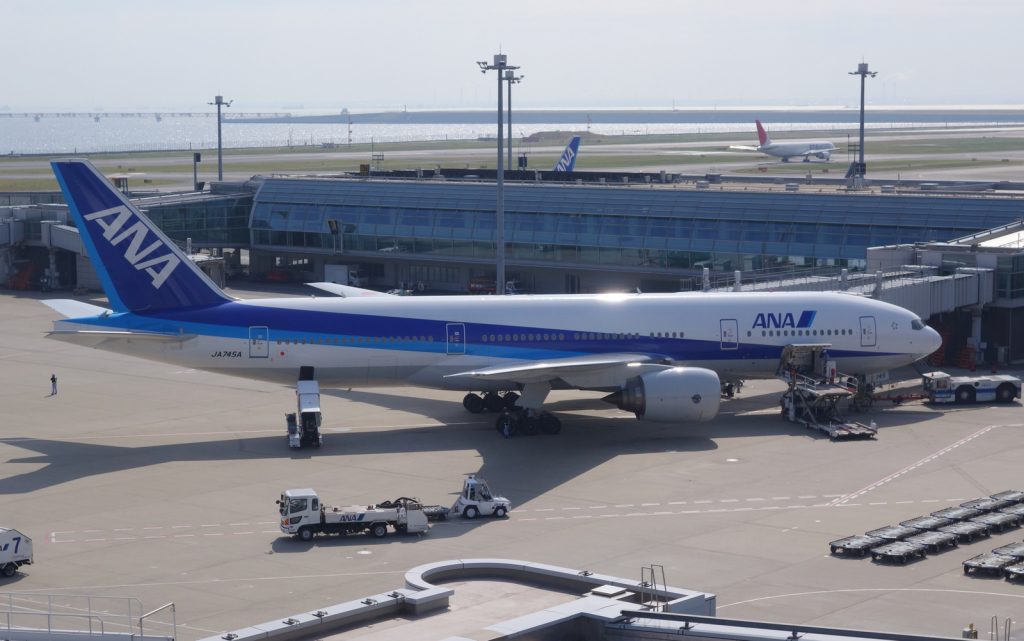
On the ramp at Tokyo-Haneda, an ANA Boeing 777-200 with a pod-loader, belt loader, & towbar tractor by the plane, and a lavatory service truck going by.
Ramp service continues when the lav and water trucks pull up. Think of a jetliner as a giant Recreational Vehicle (RV) and you’ll know what those trucks do. “Blue” and “gray” water from the lavatories and galleys is pumped out, and fresh water is pumped into the plane.
Water is heavy, too. It’s 8.3 pounds per U.S. Gallon, compared to around 6.5 pounds per U.S. gallon for Jet A fuel. In metric, water is 1 kilogram per litre (easy for calculations!), and Jet A is about 0.80 kg per litre. Either way you measure it, there’s a lot of water weight to get airborne and fly around.
Adding to the equipment now clustered around the plane, the fuel trucks need to get to the plane’s refueling station, generally located on the lower surface of the wing, just behind the leading edge. The fuel truck might be a tanker, or it could be a pump truck that connects to a fuel hydrant that’s flush mounted in the apron surface.
With a hydrant system, the fuel is pumped to all of the gates through pipes from a central storage tank farm, which makes the process more efficient than using tanker trucks. It can take some time to fill a big jet. A Boeing 747-8I will need upwards of 63,000 U.S. gallons, or over 238,000 litres for a long flight.
Sometimes, a plane isn’t refueled during a turnaround. The airline’s dispatch department will have calculated that the remaining fuel is enough for the next flight leg. Of course, these numbers are double-checked by the flight crew. In some cases, the plane has been deliberately over-fueled at its last stop, so that a fill-up isn’t necessary during the turnaround. It might be that the fuel cost at this airport is a lot higher than the cost at the last airport, and that’s a good reason to “tanker” the fuel. There are calculations to figure out whether it’s worth it – every pound of fuel tankered need so much fuel burned to carry it.
If you’re ready to board a flight, hopefully you won’t see a small pickup truck loaded with tools, work stands, and equipment. That’s the mechanic’s truck. Really, though, there is regular maintenance that can be done during a quick turnaround. But the plane might have snags that need attention before it can be released for flight. The maintenance work might result in a delay, but it’s all about safety. As pilots say, “It’s much better to be on the ground, wishing you were in the air, than being in the air and wishing you were on the ground.” Fix it before you commit flight!
The outgoing flight has now been fueled, loaded with bags and cargo, catered and provisioned; the cabin crew is onboard, passengers are finding their seats, and one of the pilots has completed a walk-around inspection of the plane. The other pilot has programmed the Flight Management System, and has the final dispatch, flight plan, and departure clearances. The APU is running to provide high-pressure air to spin the main engines up to speed for starting. But what if the APU isn’t working? Time to call for a “jet start”.
A jet start is a truck- or trailer-mounted compressor, powered by a gas or diesel engine, or it might be a small turbine similar to an APU. There’s a long, heavy-duty reinforced fabric hose attached to the jet start, about 4 inches (10 cm) in diameter,with a heavy metal coupling at the end. The coupling goes into a receptacle located behind an access door on the plane’s belly, usually somewhere around the wing root. With the jet start running, high-pressure air is routed through the hose into the plane and over to an engine. That’s enough air to get the engine spinning fast enough for it to start. Once the first engine is started, it can feed air to the other engine(s).
When I worked on the ramp at YYZ, oh so long ago, all of the early-generation planes needed a jet start. The Boeing 707s, Douglas DC-8s and Vickers VC-10s didn’t have APUs. It got exciting one evening when the hose parted from its coupling as I ran the jet start up to operating speed. I got it shut down quickly, before the flailing hose damaged the BOAC 707’s wing. It made one heck of a noise, too – imagine all of the air coming out of a giant balloon.
The GEnx-1B and Rolls-Royce Trent 1000 engines on a 787 start electrically with power generated by the APU, and not with pressurized air. Those engines have power generators that double as starters. So, with an inoperative APU, a third 90 KVA ground power connection is recommended to start the engines on a 787. More power!
Depending on the gate location and airport procedures, the plane’s engines might be started at the gate, or the plane may have to be moved to a clear and safe spot on the ramp for startup. Once everything’s ready, the pilots request clearance to pushback from the gate.
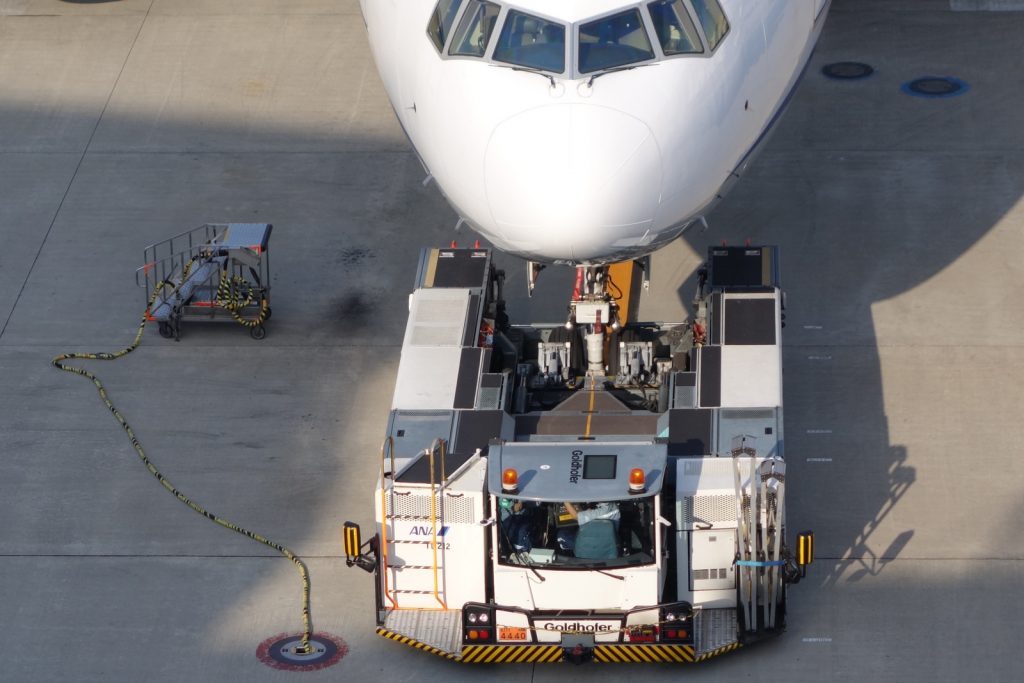
A wheel-lift tug ready to move an empty ANA 777 at Tokyo-Haneda. Look carefully, you can see the “Remove Before Flight” banner and pin on the nosegear.
The aircraft tug does the work, and is attached to the plane’s nosewheel. You’ll see two kinds of tugs. One uses a towbar, with one end attached to the tug, and the other to the nosegear. The other kind of tug is towbarless, also called a “wheel-lift” tug. The working end of the tug wraps around the plane’s nose wheel, cradles it, and lifts and holds it up. This kind of tug operates very quickly and efficiently. You’ll often see them used to move planes around the airport, and not just for pushbacks. A friend of mine, an Air Canada pilot, once told me how weird it was to feel his plane lift into the air, the first time he encountered a wheel-lift tug.
There’s an alternative to tugs coming soon. There are systems in development to give aircraft the ability to pushback and taxi with electric motors integrated into the plane’s wheels. [Click the links to read about the Honeywell/Safran EGTS and WheelTug system in two of my stories] And while some planes can back away from a gate under their own power (the Dash-8 and the ‘Diesel-9’ (DC-9) come to mind), it’s much safer if an aircraft tug maneuvers the plane. Visions of “Airplane”!
The turnaround is complete when the plane is disconnected from the tug, and the ramp crew removes the safety pin and “Remove Before Flight” banner from the nose gear, and shows it to the pilots. That’s confirmation for the pilots that they now have control of nosewheel steering. And in a nice touch, the ramp crews of some airlines wave goodbye, or even bow, to the passengers.
Turnarounds can be squeezed into as little as 25 minutes, or less, for some airlines. Large planes and longer-distance flights usually need somewhere between an hour and 90 minutes for a full turnaround. So be sure to get to the airport early next time you’re flying, and watch all of the action on the ramp.
